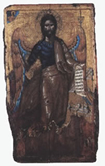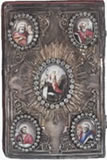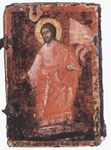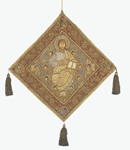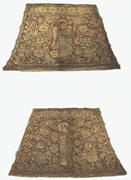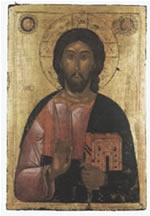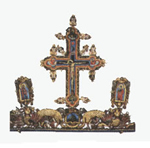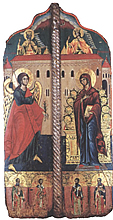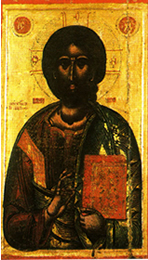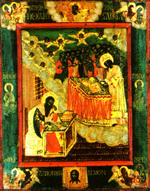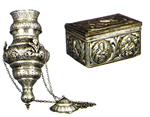ECCLESIASTICAL MUSEUM
The Odigitria Virgin Second half of the 14th Century. The Ecclesiastical Museum of the Holy Diocese of Serres and Nigrita is a labour of love for the artistic expression of the past and the religious life of our people. It is one of the most significant museum collections in Serres, and is laid out in a modern, comfortable style. Every respect has been shown for the uniqueness of the exhibits and the imaginative layout makes the best use of the space available; the exhibits are set out in three small sections within the three spacious and comfortable rooms of the museum so that they merge into a single, unified entity.
The organic, contemporary functional unity of the Ecclesiastical Museum and the chapel of Saint Nikitas, who was martyred in Serres, put paid to any objections that the only place for holy exhibits is in churches, and the exhibition area blends in perfectly with the sacred nature of the exhibits, managing to be simultaneously a modern, museum space and a place of worship.
A Gospel, 1861. Russian origin Front: the Resurrection.
A Gospel, 1614. Reverse:the Ressurection. The exhibits have all been donated by individuals from the parishes making up the Diocese of Serres, the majority of the artefacts having been donated by Mr. K. Maximou, the founder of the Museum of the Diocese of Serres and Nigrita.The exhibits have been divided into four categories: icons, wood carvings and screen sections, metal objects, and gold embroidered filigree work. The most numerous exhibits are the icons, 130 in number, followed, in numerical order, by the metal objects, wood carvings, and gold embroidery. Worth noting (in Room 2) are the two Gospels. The first dates from 1614 and was printed in Venice, as it states on the cover "In Venice, by Antonio son of Pinelos", with some hand-written additions of no importance, wooden covers which, having been suitable prepared, were illustrated with marvellous renditions of the Crucifixion and the Resurrection
Gold embroidered epigonation, 18th Century.
The second Gospel, with the velvet and metallic facing on its covers, dates from 1861 and was printed in St. Petersburg by the printers of the "Holiest Synod" of the Russian Church. The text is printed in both Russian and Greek, each page being separated into two vertically.In the second room there is a small collection of altar clothes with a note-worthy variety of iconography. Two works are particularly deserving of attention: one dates from 1841 and was consecrated by Athanasios, the Bishop of Serres, and the other from 1653 (also dated 7161 from the Creation), which, according to the inscription, was consecrated by Grigorios, the Bishop of Platamonas.The metal objects are mainly holy vessels: chalices, asterisks, tongs, and communion plates. The first, made in Russian workshops, as is eloquently born witness to by the decorative motifs and stamps of origin and sterlingness and especially the relevant inscriptions in Russian, show us the main centres of production of holy vessels and the trade routes and ties as they were from the end of the Eighteenth Century until the mid Nineteenth Century between enslaved Hellenism and the Russian people (Room 2).The centre of interest as regards the gold embroidered objects are certainly the epigonatia and cuffs with their variety of representations and decorative motifs which continue on the tradition of the once flourishing Byzantine filigree work. Two pairs of cuffs, with representations of the Annunciation of the Virgin, are considered to be the most important exhibits. The first date from 1706, and the second from the Eighteenth Century. Also of note is the eighteenth-century epigonation depicting the Lord with the cherubim (Room 3): this particular example of gold embroidered work is exceptional in its adaptation of iconography, its exceptional decoration, and its harmonious use of complementary colours.
Christ the Saviour. Second half, start of the 16th century.
Iconostasis' Cross and Lypira-19th century. Iconography is the primary expression of ecclesiastical art and an independent entity. It is just this independence enjoyed by orthodox religious painting that led to the variety of subjects and modes of expression.Certain of the icons in the museum clearly continue on from the tradition of Byzantine religious art of the later years of the Palaiologos Period, while originating, in all probability, from workshops outside of Greece. However, most of the museum's icons, as is clear from their inscriptions, were ordered from local workshops during the later years of the Ottoman period, and maintain the long Byzantine tradition outside the major artistic centres of Thessaloniki, Mount Athos, Meteora, Crete, and Constantinople.These icons, with their elements obviously inspired by folk art, are important examples of just how sophisticated orthodox iconography was, even on a local level, in the post-Byzantine period. Even though some display a certain clumsiness, they prove the profound religiosity of the Greek people in the difficult years of their slavery. Worth noting are the icons which once graced the former Cathedral of Agion Theodoron (Christ the Saviour, The Odigitria Virgin), which are among the oldest of the exhibits (Room 2), as well as the Seventeenth Century icons from the chapel of Saint Dimitrios at Saint George the Krioneritis (Christ the Saviour, the Pantanassa Virgin), which are glorious examples of the Cretan school (Room 2).
The Odigitria Virgin Second half of the 14th Century. The icon of the Armenkratousa Virgin, a work dating from 1854, is also worthy of attention for its local character and folk expression and inspiration, as well as the marvellous icon of the Odigitrias Virgin which was discovered beneath it; a fine work of art from the later years of the Fourteenth Century, which exemplifies the older school (Room 2). From the wood carvings, of particular interest are the iconostasis screen with its wonderful representation of the Annunciation of the Virgin, which dates from the Eighteenth Century and originates from the Church of Saint George in Nigrita (Room 1). The museum was created in February 1988. It has attracted the interest of local inhabitants, school children and visitors to the city. The visitor can find detailed descriptions of its exhibits in the Museum Guide which has been published by the Holy Diocese of Serres and Nigriti.
The Pantanassa Virgin, 1634.
Iconostasis screen, 18th Century. The Annunciation of the virgin, prophets, saints.
The Divine Liturgy. Second half of the 17th Century. (The icon is of interest from a liturgical and theological point of views, as well as for the rarity of icons with this subject matter).
Kandila, 1846. (It comes from the church of Saint Charalampos Yosgatis, Asia Minor. There is a Karamanlidian inscription aroun the edges).
Pyx - 19th century.
Writer:
Athanasios Kanlis

